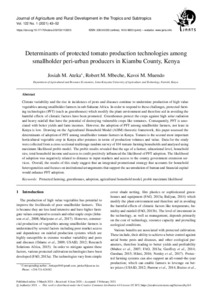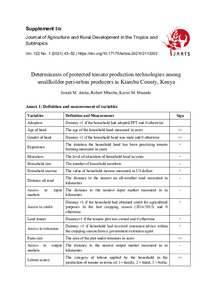| dc.date.accessioned | 2021-03-09T15:14:42Z | |
| dc.date.available | 2021-03-09T15:14:42Z | |
| dc.date.issued | 2021-03-05 | |
| dc.identifier | doi:10.17170/kobra-202102113203 | |
| dc.identifier.uri | http://hdl.handle.net/123456789/12600 | |
| dc.language.iso | eng | eng |
| dc.rights | Namensnennung 4.0 International | * |
| dc.rights.uri | http://creativecommons.org/licenses/by/4.0/ | * |
| dc.subject | protected farming | eng |
| dc.subject | greenhouses | eng |
| dc.subject | adoption | eng |
| dc.subject | agricultural household | eng |
| dc.subject | probit maximum likelihood | eng |
| dc.subject.ddc | 630 | |
| dc.title | Determinants of protected tomato production technologies among smallholder peri-urban producers in Kiambu, Kenya | eng |
| dc.type | Aufsatz | |
| dcterms.abstract | Climate variability and the rise in incidences of pests and diseases continue to undermine production of high value vegetables among smallholder farmers in sub-Saharan Africa. In order to respond to these challenges, protected farming technologies (PFT) (such as greenhouses) which modify the plant environment and therefore aid in avoiding the harmful eects of climatic factors have been promoted. Greenhouses protect the crops against high solar radiation and heavy rainfall that have the potential of destroying vulnerable crops like tomatoes. Consequently, PFT is associated with better yields and farm incomes. However, the adoption of PFT among smallholder farmers, not least in Kenya is low. Drawing on the Agricultural Household Model (AHM) theoretic framework, this paper assessed the determinants of adoption of PFT among smallholder tomato farmers in Kenya. Tomato is the second most important horticultural vegetable crop in Kenya after potatoes in terms of production volumes and value. Data for the study were collected from a cross sectional multistage random survey of 104 tomato farming households and analysed using maximum likelihood probit model. The probit results revealed that the age of a farmer, educational level, household size, total household income and access to credit positively influenced the likelihood of PFT adoption. The likelihood of adoption was negatively related to distance to input markets and access to the county government extension services. Overall, the results of this study suggest that an integrated promotional strategy that accounts for household heterogeneities and focuses on institutional arrangements that support the accumulation of human and financial capital would enhance PFT adoption. | eng |
| dcterms.accessRights | open access | |
| dcterms.creator | Ateka, Josiah M. | |
| dcterms.creator | Mbeche, Robert M. | |
| dcterms.creator | Muendo, Kavoi Mutuku | |
| dc.subject.swd | Kenia | ger |
| dc.subject.swd | Gemüseproduktion | ger |
| dc.subject.swd | Gewächshaus | ger |
| dc.subject.swd | Tomatenanbau | ger |
| dc.subject.swd | Ländlicher Haushalt | ger |
| dc.subject.swd | Probit-Modell | ger |
| dc.subject.swd | Maximum-Likelihood-Schätzung | ger |
| dc.type.version | publishedVersion | |
| dcterms.source.identifier | EISSN 2363-6033 | |
| dcterms.source.issue | No. 1 | |
| dcterms.source.journal | Journal of Agriculture and Rural Development in the Tropics and Subtropics (JARTS) | eng |
| dcterms.source.pageinfo | 43-52 | |
| dcterms.source.volume | Vol. 122 | |
| kup.iskup | false | |



